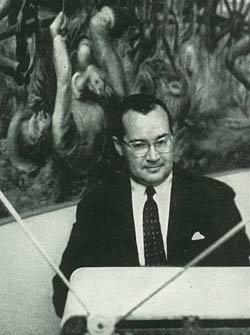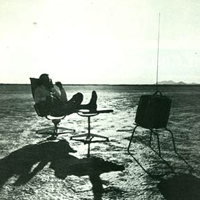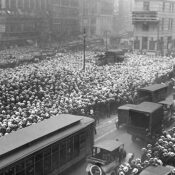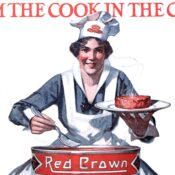America has learned not to expect too much from television. We no longer assume the programs of commercial television will display a consistently high level of morals and art. We’re just happy to find an occasional show that interests us.
It wasn’t always this way. Back in the early 1960s, many Americans were deeply concerned over what they saw as a lack of quality in television programming.
They had allowed television into their homes because it had promised them art, information, and entertainment. But after a decade of network broadcasting, most of what they got was mindless entertainment. Or so Newton Minow believed, and he was the head of the Federal Communications Commission. In 1961, he invited the country’s broadcasters—
“to sit down in front of your own television set when your station goes on the air and stay there, for a day… Keep your eyes glued to that set until the station signs off. I can assure you that what you will observe is a vast wasteland.”

Originally, that line in the speech read “a vast wasteland of junk.” That’s how Minow’s speechwriter, John Bartlow Martin, had expressed it after watching an entire broadcast day of a Chicago station. In those 15 hours, he saw little more than cheap, unimaginative programming and an endless torrent of advertising.
The commercials, loud and frequent and long, seemed stupefying. One commercial asked, “Would you prefer this kind of whiteness?”… [When another] inquired, “Is your bathroom guestroom-fresh? Just one light whizzer whoosh in your bathroom.…” nearly 3,000,000 of us watched.
[By mid-morning, I had] witnessed some seventy commercials.
In the preceding nine hours, except for the news broadcasts and two brief interviews on the Today Show, nobody on Channel 5 had discussed a single idea.
The game shows of the morning were succeeded by soap operas in the afternoon.
We were entertained by Young Dr. Malone, a somewhat mystifying program to a one-time watcher, because so much seemed to have gone before, and From These Roots, which presented the same difficulty, though it did contain one memorable line… “Why, I’m in better shape now than I was before my brain operation.”
By the time he reached prime time, he wasn’t enjoying anything, not even the program called “the hottest show in television”: Sing Along With Mitch.
Mitch said, “Hi. Here we are again—to stir up the fires of memory,” and invited us in 11,700,000 homes to join him in singing “By the Light of the Silvery Moon.” The author did not join him and has no way of knowing how many of his fellow watchers joined him. Mitch introduced elaborate production numbers, with costumed dancers and singers and what looked to be a live horse. He was sponsored by cereal, eye make-up, wine and a soda drink. Near the end he said. “At this point anyone out there who’s not clutching the hand of someone he loves has a cold, cold heart.”
Which, after 15 hours, was Mr. Martin.
After wading through the trite violence of detective shows and the vapid chatter of talk shows, he thought the shows well deserved the description of “junk.”
Many intellectuals think it may be making idiots of us and destroying American culture.
Parents and educators deplore its effect on children.
Denouncing television is a national pastime.
The quality of television was a serious concern to Americans who’d seen the influence of television grow like nothing before it.
In 1946, 8,000 homes had television sets. Today 47,000,000 homes have them. In addition 5,500,000 homes have second sets, and public places have 1,500,000. Television is virtually inescapable.
In one month this year the average American home television set was turned on for six hours a day. Maybe some of that time nobody is watching. Advertisers doubt it; they spent more than $1,5000,000,000 on television in 1959.
All that money, Martin suggested, was pressuring the networks to churn out programs with no merit other than to generate large clumps of viewers.
But Americans still expected the networks to live up to a standard of good taste and service that would earn them the license to use the “public airwaves.” But public good was being outweighed by the desire to attract advertiser with the biggest viewership possible.

From this arises the “tyranny of ratings.” The A.C. Nielsen Company… attached an electronic device, to television sets in each of 1200 homes… mintended to represent a true sampling of American families…
Ratings have been hotly attacked.
Critics complain bitterly that ratings are abused. Ratings determine which programs stay on the air
and which go off. An evening show whose rating falls below 17 is likely to be dropped—it simply is not reaching enough people. Yet critics point out that such a program reaches more than 8,000,000 homes—can such a program be called a failure? And many things affect a program’s rating—how many local stations carried it, what programs it competed with, what program preceded it, even the weather.LeRoy Collins, president of the National Association of Broadcasters, has said, “Ratings are a maze of statistics built from scanty facts. And they are like dope addiction in this industry. There is too much equating with the public interest what interests the public.”
One network producer was still promoting quality of programs over quantity of viewers. Fred Friendly, who would later become president of CBS, thought the FCC should be concerned that television might become a “vast wasteland.”
[Television] will get like Times Square. Times Square real estate used to have great value. But today it’s all gaudy and trashy, with jukeboxes and popcorn and junk, and much of it has lost property value and gone down, down, down. And television could go the same way.
He couldn’t have known then how prophetic was his next statement:
“If you breed a generation of Americans that wants to see excitement and violence all night, that’s all the audience you’re going to get.
POST script:
Just how bad were the prime-time programs of 1961? Some critics now consider the wasteland year to be the golden age of television, e.g.,
- Ed Sullivan
- Jack Benny
- The Andy Griffith Show
- Cheyenne
- Peter Gunn
- The Rifleman
- Wyatt Earp
- The Many Loves of Dobie Gillis
- Wanted Dead or Alive (with Steve McQueen)
- Hawaiian Eye (with a young Robert Conrad)
- Wagon Train
- The Untouchables
- The Real McCoys
- Bat Masterson
- 77 Sunset Strip
- Route 66
- Leave It To Beaver
- The Lawrence Welk Show
- Have Gun—Will Travel
- Gunsmoke
- Perry Mason
- Bonanza
- Rawhide
- The Flintstones
- Walt Disney Presents
- The Dick Van Dyke Show
- Alfred Hitchcock Presents
- My Three Sons
- The Twilight Zone
Become a Saturday Evening Post member and enjoy unlimited access. Subscribe now



